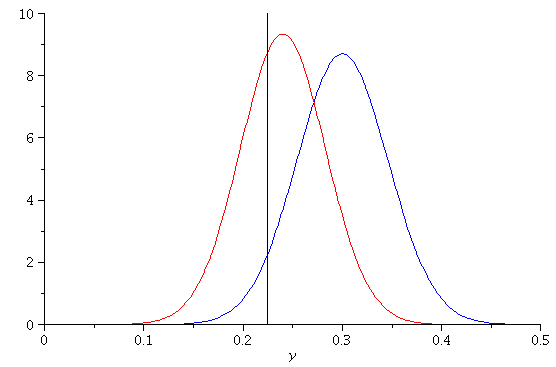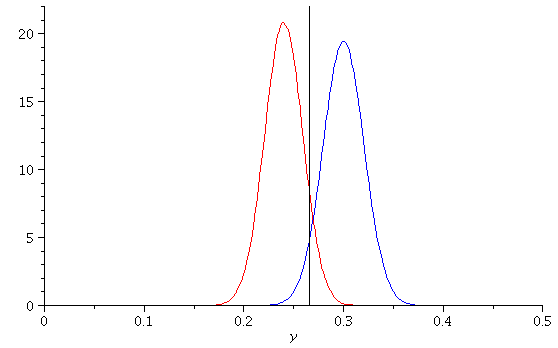MATH 376 -- Probability and Statistics II
Type II Error Probabilities for a large-sample lower-tail Z-test
March 25, 2010
We consider testing for value of a proportion. Say the null
hypothesis is ![]() : p = .3 and the alternative hypothesis is
: p = .3 and the alternative hypothesis is
![]() : p < .3. We will assume n is always large enough
: p < .3. We will assume n is always large enough
so that our general discussions of the large-sample tests applies.
The test statistic is z = and the rejection region for
and the rejection region for
an ![]() -level test is RR = { z < - z_.05 } = { z < -1.645 } or {Y/n < .3 - 1.645
-level test is RR = { z < - z_.05 } = { z < -1.645 } or {Y/n < .3 - 1.645![]() }.
}.
Set-up:
| > | sigma[1]:=n->sqrt((.3)*(.7)/n); |
| (1) |
The normal pdf under the assumption that ![]() is true:
is true:
| > | f[1]:=n->1/sqrt(2*Pi*sigma[1](n)^2)*exp(-(y-.3)^2/(2*sigma[1](n)^2)); |
, 2))))))), `*`(sqrt(`+`(`*`(2, `*`(Pi, `*`(`^`(sigma[1](n), 2)))))))) end pr...](images/TypeII_8.gif) |
(2) |
But now suppose that the actual value of p is .24. We ask: How likely are
we to make a Type II error with the ![]() = .05-level rejection region given above?
= .05-level rejection region given above?
Here's the normal pdf that approximates the distribution with p = .24:
| > | sigma[2]:=n->sqrt((.24)*(.76)/n); |
| (3) |
| > | f[2]:=n->1/sqrt(2*Pi*sigma[2](n)^2)*exp(-(y-.24)^2/(2*sigma[2](n)^2)); |
, 2))))))), `*`(sqrt(`+`(`*`(2, `*`(Pi, `*`(`^`(sigma[2](n), 2)))))))) end p...](images/TypeII_11.gif) |
(4) |
| > | RR:=n->.3-1.645*sigma[1](n); |
| (5) |
The following plot shows the normal densities for the sampling distribution
of Y/100:
blue plot (shorter normal curve) = if ![]() is true
is true
red plot (taller normal curve) = if ![]() is false and actual p = .24
is false and actual p = .24
The vertical black line is plotted at the value .2246 (the upper edge of the RR taking
n = 100.)
| > | RR(100); |
| (6) |
| > | Dists:=plot([f[1](100),f[2](100)],y=0..0.5,color=[blue,red]): |
| > | RRPlot:=plot([RR(100),t,t=0..10],color=black): |
| > | with(plots): |
| > | display(Dists,RRPlot); |
 |
The area under the shorter normal curve to the left of the vertical line is the probability
of a Type I error:
| > | evalf(Int(f[1](100),y=-infinity..RR(100))); |
| (7) |
This checks with the desired value ![]() = .05 The area under the taller normal curve to the
= .05 The area under the taller normal curve to the
right of the vertical line is the probability of a Type II error (always assuming p = .24):
| > | evalf(Int(f[2](100),y=RR(100)..infinity)); |
| (8) |
This is certainly unacceptably large! What can we do to decrease it?
The answer is: Increase the sample size(!) Increasing n decreases the variances of both
distributions (so the pdf's get taller and skinnier), and moves the cut-off for the RR for the
.05-level test farther to the right. For instance the picture for n = 500 is:
| > | RR(500); |
| (9) |
| > | Dists:=plot([f[1](500),f[2](500)],y=0..0.5,color=[blue,red]): |
| > | RRPlot:=plot([RR(500),t,t=0..22],color=black): |
| > | display(Dists,RRPlot); |
 |
| > |
| (10) |
| > | evalf(Int(f[2](500),y=RR(500)..infinity)); |
| (11) |
So the Type II error probability ![]() has been reduced to .084 by increasing n to 500,
has been reduced to .084 by increasing n to 500,
while ![]() = .05 still. In class we showed that
= .05 still. In class we showed that ![]() can be reduced to any given value
can be reduced to any given value
by taking n sufficiently large.